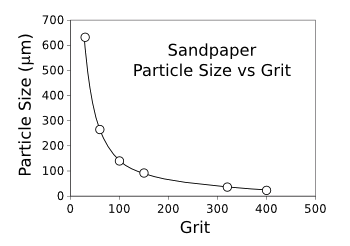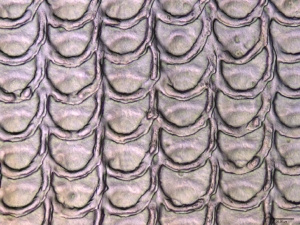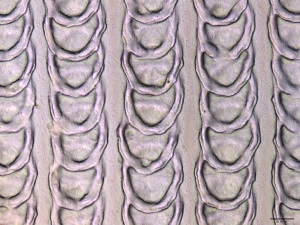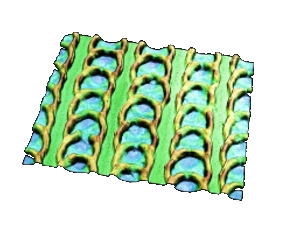Snakeskin Texturing
September 28, 2015
I was educated in the time when "
wood shop" was still a part of an
elementary school education, at least for the boys. In those days of full
gender stereotyping, the girls were shuffled off to "
home economics." I've done quite a lot of
woodworking, having learned may tricks from my
father, who was a
carpenter. He learned from his father, who was a carpenter and
cabinet-maker.
Saws,
chisels, and
files are good for rough-forming of
wood, but the better pieces are finished with
sandpaper. Sandpaper for wood working is typically made by
gluing particles of
garnet or
aluminum oxide onto thick paper. The form of aluminum oxide is typically
corundum, which is aluminum oxide with traces of some
transition metals.
Sandpaper is graded by grit; that is, a number specific to the average size of the
abrasive particles. Extra coarse sandpaper, for removal of
paint and
varnish from surfaces, has particles more than a half
millimeter in size, while the particles in super fine sandpaper, used for a final
polish, are more than an
order of magnitude smaller. The following chart lists the particles sizes for various sandpaper grades.
| |
Grade |
Grit | Particle Size
(micrometer) |
| | Extra Coarse | 30 | 632 |
| | Medium | 60 | 265 |
| | Fine | 100 | 140 |
| | Very Fine | 150 | 92 |
| | Extra Fine | 320 | 36 |
| | Super Fine | 400 | 23 |
Sandpaper is a good example that the
properties of materials depend on their
structure as well as their
composition. The
atomically-smooth surfaces of polished
wafers of garnet or
sapphire, which are the same
materials as sandpaper grit, won't abrade anything. They're the limiting case of sandpaper in which the particle size goes to zero, although it can be argued,
philosophically, that the particle size becomes the wafer
diameter.

Particle size of sandpaper as a function of grit number
It's close to an exponential function, but not exactly.
(Graphed using Gnumeric.)
Scientists at the
Institute for Applied Materials of the
Karlsruhe Institute of Technology (Karlsruhe, Germany) have used the idea that surface structure modifies material properties in a
biomimetic approach to
friction reduction for
steel surfaces.[1-3] They
laser-scribed textures inspired by
snake scales onto the
alloy surface, and they found that friction was reduced in the dry state by more than 40%.[1] Says
Christian Greiner, principal
author of the study, "If we'd managed just a 1% reduction in friction, our
engineering colleagues would have been delighted; 40% really is a leap forward and everyone is very excited."[3]
Interestingly, the scale patterns caused an increase in friction when the surfaces were
lubricated with
mineral oil, sometimes by a factor of three.[1,3] Says Greiner, "This wasn't a huge surprise, since we were looking to
nature for inspiration, and the
species we mimicked – the
royal python (Phyton regius) and a
lizard called a
sandfish skink (Scincus scincus) – live in very
dry environments and don't secrete
oils or other
liquids onto their
skin."[3]
Biomimetics has been applied successfully to several engineering problems, but bio-inspired surface texturing is a relatively new
research field.[1] An efficient way to texture surfaces is by
laser, and laser processing to create
circular dimples produced an 80% friction reduction in unidirectional steel-on-steel sliding in the presence of a
lubricant.[1]
The
German researchers decided to try patterns that mimic the scales of snakes and certain lizards.[1] As shown in the following figures, they used two patterns, one with completely overlapping scales, and the other with scales arranged in individual rows.[1] The biomimicry was inspired by the
ventral scales of the Phyton regius, and the Scincus scincus sandfish lizard. The skin of the sandfish is known for low friction and its resistance to wear against
sand, and a
replica of its surface has already been shown to have a high resistance to
erosion by particles.[1]

Horizontally overlapping scale structure.
(Karlsruhe Institute of Technology interferometer image by Christian Greiner.)

Vertically overlapping scale structure.
(Karlsruhe Institute of Technology interferometer image by Christian Greiner.)
The
experiments were done using an
alloy steel of
iron containing 1.5%
chromium and 1.0%
carbon). A 7.5 mm diameter area was polished to flatness using a
colloidal silica suspension.[1] The surface texturing was done with a
Q-switched ytterbium fiber laser. The pattern dimensions were determined by what could successfully be laser textured, resulting in a feature size of about 50
micrometers and a raised texture of about 5 micrometers.[1] Says Greiner,
"The distance between the rows in our experiment was the smallest possible distance we could produce with the laser. The structure, hence, does not entirely correspond to that of the sandfish skink."[2]
While the dimensions of the laser-generated pattern were of the order of 50 μm, snake scales have a feature size of about 300 - 600
nanometers, while the scales of a sandfish are 2
millimeter x 3 millimeter. The counter material for lubricated friction tests was an an alloy of the same composition. For the dry friction tests, however, this contact material experienced severe
galling. For those tests, high
hardness sapphire disks were used as the counter material.[1]
Snake skin shows an
anisotropy in its friction depending on the direction of travel, with the sliding friction being smallest in the travel direction. The artificially produced textures demonstrated reduced friction in at least two direction.[3] With use of a mineral oil lubricant, large dimension patterns increased friction by a factor of 1.6, while small patterns increases friction by a factor of 3.[2] In the dry state, the large dimension patterns reduced friction by more than 40 percent, while small patterns reduced friction by 22 percent.[2] The friction difference between dry and lubricated surfaces was unexpected.[2]

A 3-D image of the scale-like structure.
(Karlsruhe Institute of Technology image by Christian Greiner.)
These results may have application where contacting surfaces can't be lubricated, such as in
vacuum systems.[1] The authors of the study suggest application in such devices as
sensors in
automobile anti-lock braking systems, and
actuators in
mechanical hard disk drives for
computers.[3] There may even be an application in snake-shaped
robots.[3] There are plans for a more detailed study of how the feature size affects the tribological performance.[1-2] This research was funded by the
Deutsche Forschungsgemeinschaft.[1]
References:
- Christian Greiner and Michael Schäfer, "Bio-inspired scale-like surface textures and their tribological properties," Bioinspiration & Biomimetics, vol. 10, no. 4 (August, 2015), doi:10.1088/1748-3190/10/4/044001
This is an open access publication with a PDF file available here.
- Snake Scales Protect Steel against Friction, Karlsruhe Institute of Technology Press Release No. 089/2015, August 6, 2015.
- Friction reduction breakthrough is no snake oil, Institute of Physics Press Release, July 1, 2015.
Permanent Link to this article
Linked Keywords: Wood shop; elementary school education; gender stereotype; home economics; woodworking; father; carpentry; carpenter; cabinetry; cabinet-maker; saw; chisel; file; wood; sandpaper; adhesive; glue; particle; garnet; aluminum oxide; corundum; transition metal; abrasive; paint; varnish; millimeter; polish; order of magnitude; properties of materials; structure; composition; atom; atomically-smooth; wafer; sapphire; material; philosophy; philosophical; diameter; exponential function; Gnumeric; scientist; Institute for Applied Materials; Karlsruhe Institute of Technology (Karlsruhe, Germany); biomimetics; biomimetic; friction; steel; laser beam machining; laser-scribe; snake; scale; alloy; Christian Greiner; author; engineering; colleague; lubrication; lubricated; mineral oil; nature; species; Python regius; royal python; lizard; Scincus scincus; sandfish skink; arid; dry environment; oil; liquid; skin; research; laser; circle; circular; lubricant; Germany; German; research; researcher; ventral scales; sand; replica; erosion; horizontal; vertical; experiment; alloy steel; iron; chromium; carbon; colloidal silica; suspension; Q-switching; Q-switched; Ytterbium; fiber laser; micrometer; nanometer; millimeter; galling; hardness; anisotropy; vacuum chamber; vacuum system; sensor; automobile; anti-lock braking system; actuator; mechanical hard disk drive; computer; robots; German Research Foundation; Deutsche Forschungsgemeinschaft.